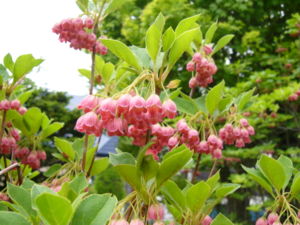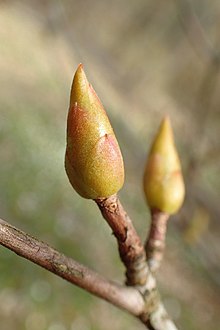Bell-shaped splendid bell
| Bell-shaped splendid bell | ||||||||||||
|---|---|---|---|---|---|---|---|---|---|---|---|---|

Bell-shaped magnificent bell ( Enkianthus campanulatus ) |
||||||||||||
| Systematics | ||||||||||||
|
||||||||||||
| Scientific name | ||||||||||||
| Enkianthus campanulatus | ||||||||||||
| ( Miq. ) G. Nicholson |
The magnificent bell ( Enkianthus campanulatus ), usually called Japanese magnificent bell , is a species of magnificent bell ( Enkianthus ) within the heather family (Ericaceae). It occurs only on the Japanese islands of southern Hokkaido , Honshu and Shikoku . It is used as an ornamental plant.
description
Vegetative characteristics
Enkianthus campanulatus grows a deciduous, richly branched shrub or small tree and reaches heights of 2 to 3 meters, more rarely up to 5 meters. When young, the growth is slender and upright, the branches are lively arranged. The growth becomes looser with age, but remains upright.
The alternate heaped on the branch ends arranged leaves are divided into petiole and leaf blade. The simple leaf blade is oblong with a length of 3 to 7 centimeters, obovate to elliptical with a sharply pointed upper end and a finely serrated edge. Both leaf sides are hairy with bristles. Especially in a bright location, a splendid autumn color develops, which ranges from a fiery red to orange-yellow.
Generative characteristics
The flowering time is in May after the leaf has unfolded until June. Ten to twenty relatively small flowers hang together in umbrella-like inflorescences . The hermaphroditic flowers are radial symmetry and five-fold with a double flower envelope . The bell-shaped corollas have an entire border and are yellowish to light orange with fine red markings and therefore appear salmon-colored from a distance. The stamens are much shorter than the corolla.
The capsule fruits are ellipsoidal with a length of 5 to 7 millimeters.
Taxonomy
The first description was in 1863 under the name (Basionym) Andromeda campanulata by Friedrich Anton Wilhelm Miquel in Annales Musei Botanici Lugduno-Batavi , 1, page 31-32 The new combination to Enkianthus campanulatus (Miq.) G. Nicholson was in 1884 by George Nicholson in The Illustrated Dictionary of Gardening, ... , 1, page 510 published. The specific epithet campanulatus means bell-shaped.
Use as an ornamental plant
The Japanese magnificent bell is used as an ornamental plant in some varieties . Enkianthus campanulatus thrives best on humic and acidic soils . It can stand in partial shade as well as in the sun, but care must be taken to ensure sufficient soil moisture. It thrives in USDA Climate Zones 4 through 7.
For example, in addition to rhododendrons , Japanese maple , Japanese flowering cherry and bamboo species , the Japanese magnificent bell results in an East Asian mixture that can be designed as a corresponding garden landscape, i.e. Asian garden.
symbolism
Enkianthus campanulatus is the symbol of the Japanese city of Nakatsugawa .
Individual evidence
- ^ A b c Enkianthus campanulatus in the Germplasm Resources Information Network (GRIN), USDA , ARS , National Genetic Resources Program. National Germplasm Resources Laboratory, Beltsville, Maryland. Retrieved November 12, 2018.
- ↑ a b c d e f Datasheet with illustrations at Missouri Botanical Garden .
- ↑ a b c d e data sheet with images at Baumkunde.de .
- ^ Miquel, 1863: scanned in at biodiversitylibrary.org .
- ↑ George Nicholson, 1884: scanned at biodiversitylibrary.org .
- ^ Enkianthus campanulatus at Tropicos.org. Missouri Botanical Garden, St. Louis, Retrieved November 12, 2018.
Web links
further reading
- Liang, Ying-Mei, Cheng-Ming Tian, Kazuyuki Hiratsuka, Makoto Kakishima: A new species of Pucciniastrum on Enkianthus campanulatus from Japan. In: Mycotaxon , Volume 92, 2005, pp. 371-376. Abstract, text online and web link to PDF.
- PDF: 2016 Members' Plant Dividend - Enkianthus campanulatus at the Arnold Arboretum .



